
Hakone, pronounced (Ha as in Ha Ha Ha, and Ko as in the first and thrid syllable of Coca−Cola and Ne as in Never.) is an area of Japan southwest of Tokyo near Mt. Fuji. As far as I knew it was mostly famous for Onsen (hot spring baths). I got to go a year ago with my friends from Sega in December 1999 but we went by car. It seemed like it took almost 3 hours by car. I'm not sure if we when the round about way or if it just seemed like 3 hours and was really only 2.
That time that I went it was neat to go and it was my first onsen experience but it didn't seem like some place I'd want to go again really. Very pretty but not much to do. Especially without a car. Lots of driving around pretty and twisty mountain roads and stuff but not much else.
What I didn't know was that I really didn't have the complete Hakone experience. Maybe I still haven't. I'm not sure but I was very surprised this second time.
My mother had read a little about it in some literature she got from the Japan Tourist Association and she wanted to go. I was a little hesitant at first because with my first experience it didn't really seem like there was going to be much to do but I finally looked it up in a guide book I had and they had a little more information on how to get started so we set out to get reservations. But, better than that when we went to the train station we found they had a special package deal all setup. It was only 9500 yen each. I interpret that as $95 each but at the current exchange rate it's actually more like $75. That included reserved seats aboard an express train to Hakone−Yumoto, Bus tickets to Moto−Hakone, Lunch, tickets for a boat ride across the lake, and a pass for a ropeway, a cablecar, a switchback train and of course the ride back. Pretty good deal. Any they had English instructions with maps of each place telling you how to get from one transportation system to the next.
It's a day long trip. The train leaves Shinjuku station at 9am and you get back around 7pm.
So, first we got on the train. It's about 90 minutes to the first stop which is Hakone−Yumoto, called "the Gateway to Hakone". It's a small down near the end of a valley coming out of the mountains.
From there we caught the bus to Moto−Hakone. This was the scariest part of the trip. The road is very twisty and very narrow and there's lots of traffic. I could have sworn we had less than 6 inches clearance between say a rock wall on the left and on−coming traffic on the right sometimes. You can see a video clip of it here. You'll need the Windows Media Player 7 or something else that will play it.
Anyway the bus ride is about 30 minutes and drops you off right on lake Ashi in Moto−Hakone.
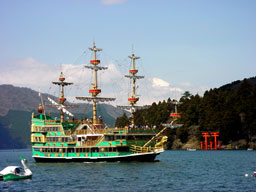
You can see Mount Fuji in the top picture on this page. That was taken just after we got off the bus as were the two pictures here.
I have no idea why but they have reproductions of British ships on the lake. 3 of them actually. They go back and forth across the lake to 3 different destinations all day long. There's also a 4th that looks like a river boat.

I think this shrine on the lake is one of the most famous images from Japan. Actually as far as I know there are others but still it's a great image. I have no idea how old it is.
From Moto−Hakone you take a "40" minute walk to Hakonemachi. Along the way you walk down "Cedar Avenue" which is supposedly part of the major path they used to use to go from Kyoto to Edo (now called Tokyo) hundreds of years ago.

From there you go to the Hakone Checkpoint. Sorry but I didn't take any pictures. There was a small museum there. Hundreds of years ago if you were traveling from Kyoto to Edo you had to check in at this checkpoint. Of course you *could* get around it pretty easily but if you were caught having not gone though the checkpoint you'd be crucified. They had some pretty intimidating weapons too.
There was some thing there too about some of the customs of the time. Like in order to prevent a rebellion when you went somewhere you had to leave your wife behind. She was kept as insurance that you'd come back and do the right thing.
Around there there are a few souvenir shops. It's a custom in Japan the when you go on a trip you have to bring back Omiyage. Omiyage (oh−me−ah−gay) is specifically gifts from trips. Generally you buy some kind of package of local food like candy or crackers or cookies. They are each individually wrapped so when you get back you can take the package to the office or school, open the package and everybody can take one thus satisfying your Omiyage obligation. Maybe because of this tradition all touristy places in Japan have tons of stuff for you to buy just for that purpose.
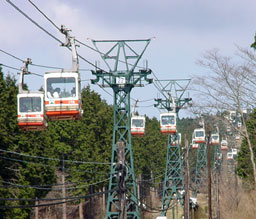
The ride across the lake takes about 30 mintues and ends in Togendai where you can board a ropeway. There is also a hotel here so I guess you could say if you had made plans.
It was kind of "Natsukashii" (nostalgic) to ride the ropeway. Although the cars are bigger it was very much like the Skyway that used to run at Disneyland. I'm not sure why they closed the Skyway at Disneyland. I was sad to see it go. Speculation was that the insurance rates got too high. I wonder if it was more that people threw stuff from the cars. I really have no idea though. Magic Mountain closed theirs too.

There are 4 stations on the ropeway. The second one is called Owakudani and they recommend you get off there can check out the steam vents and geysers. Actually Owakudani is a crater made from eruptions almost 3000 years ago.
There were a lot more souvenir shops here. I got some wasabi sembe (crackers) and before at the lake I got some black sesame seed candy. Both are supposed to be unique to Hakone.
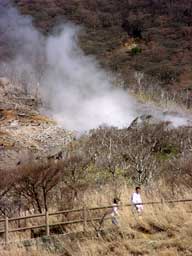
I also tried wasabi ice cream. Yes, you read that right. It tasted like somebody at mixed real wasabi with ice cream. I'm not sure I'd recommend it. It wasn't that it tasted bad. It was a little spicy but there was something about it. I felt like if I ate it all I might get an upset stomach. I ate about half.
They also had *famous black eggs*. They say "one egg will add seven years to your life.". Hmmm, looking at them I got the impression they would take a few years off your life. Whatever, I had to try one. I think I was expecting like Pitan, duck eggs. I think the Chinese call them 1000 year old eggs. Pitan, which you can get in Ranch 99 in Southern California are actually black all the way through. The one I had tasted mostly like a hard boiled egg but the yolk was wetter than a chicken egg.

The famous black eggs of Hakone are chicken eggs. What makes them black is they are actually cooked in the geysers. If you climb up the mountain a little ways there are holes in the ground with super boiling water. The water looks light bluish green. Almost like a milky bluish jade green and it looks HOT!!. I'm surprised you can stand like 2 feet from it. I would expect that it's not safe. That once in a while an some extra pressure squirts the water further than is safe but then maybe not. I don't get the impression that Japan as the same legal *problems* the U.S. has. Worse than that there are signs all over that says breathing the sulfur fumes is bad for you so don't stick around too long yet they are people working up there all day long making and selling the eggs.

I'm really still not sure what makes the eggs black. Is the water so hot that the outside gets burnt. The black didn't seem to rub off. Some of eggs were not completely black and looked like they had been boiled in something black though by the marks on the outside.
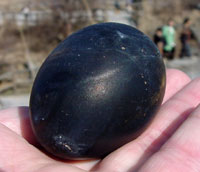
Anyway I bought some to try. Unfortunately you can only by them in packs of 4 for 500 yen ($4) and as my Mom and Grandma didn't want to try them and as I didn't want to carry the other 3 home I ended up throwing the other 3 away. I suppose if I was outgoing I would have asked some other people that only wanted one to go in together to get'em. Well, after all that, once it was peeled it looked just like any other hard boiled chicken egg and it tasted just like any other chicken egg. Hopefully it will add 7 years to my life though 😉

After that you get back on the ropeway and take it to Sounzan station. Here you get aboard a cablecar. There's a cablecar like this at Magic Mountain except the one at Magic Mountain doesn't go nearly as far. This one goes far enough that there are 5 stations. The 2 at the ends and 3 in the middle. You can't tell from this picture but it seems pretty steep when you're on it. There are two cars connected by one cable at the top station. The two cars balance each other and pass each other in the middle.
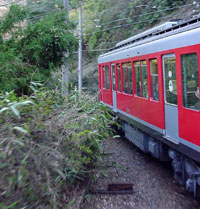
From the last stop on the cablecar you get on a Switchback train. A switchback train is a train that goes down a mountain and since there's no room to turn around it pulls into several dead ends, a switch in track changes and then it reverses direction to take the down track going back and forth down the mountain. This train switched back 4 times and trains coming up the mountain passed at the stations. My mom at first didn't get it and was wondering why we kept going back and forth. I guess she thought we were just going back and forth between the same places.

The switchback ends back at Hakone−Yumoto where we boarded the bus. We got there at about 4pm and our train reservations weren't till 5:40 so we looked around the town a little (which is almost all Omiyage shops) and then we hung out at a small cafe and had some coffee and tea. We were a little pooped from all the walking (and it turned out we were getting sick from a cold my mom brought with her 😞. Oh well. It was still very cool.
One thing we skipped that I kind of wish we had done. At one of the swtichback stations you can get off and visit the Hakone Open−Air Museum. I could see it from the switchback train. It was a fairly large garden with very modern sculptures. It actually looked kind of interesting but as we were kind of tired we skipped it.
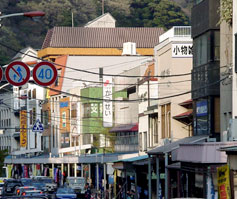
If you get a chance I recommend you check Hakone out. If you want to go just set aside a day. You can knap on the train both there and back as both stops are the end of the line so you don't have to worry about missing your stop.
I'm sure you can make reservations early. We were lucky I guess that it was off season so it wasn't that crowded and we got reservations the day before. I think the most crowded time is probably in October when all the leaves are changing into bright and beautiful colors. Maybe I'll have to check it out again!
The place to go is to the Odakyu Tourist Ticket Counter on the 1st floor of the Odakyu department store on the West side of Shinjuku station. I think they are only open until 5pm so don't go too late. If you go to the West exit of Shinjuku station there are two big department stores that are part of the station, the Keio store and the Odakyu store. One thing, be sure you are on the first floor of the Odakyu store (the most common place to be is the basement because 3 train lines connect there. The area to be in is directly above the Central West Exit. There are signs (all be it a little small) that point the direction to the ticket counter. The people at the counter spoke English so it will be very easy to setup and they explained what to expect and gave out a pamphlet with English instructions. 😊